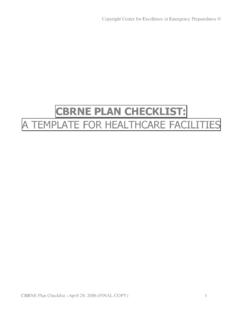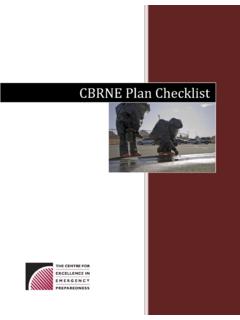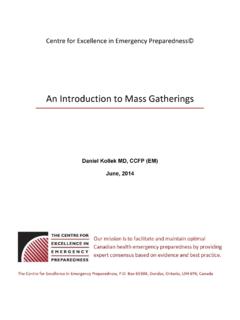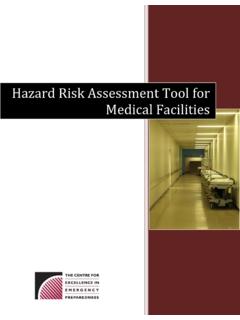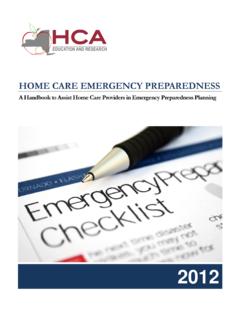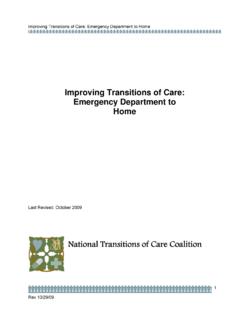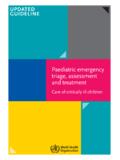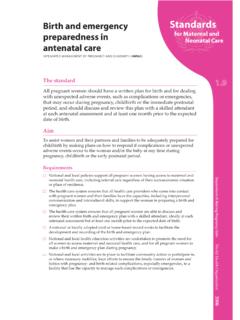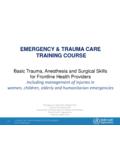Transcription of Emergency preparedness: what every health care …
1 EDUCATION DUCATION. Emergency MEDICAL SERVICES. Emergency preparedness : what every health care worker needs to know Michael D. Christian, MD;* Daniel Kollek, MD;* Brian Schwartz, MD, FCFP* . ABSTRACT. Canada is moving forward quickly with plans to ensure that it is prepared to deal with emergen- cies. The National Framework for health Emergency Management, released Nov. 26, 2004, recom- mends that a National health Incident Management System (IMS) be developed. However, al- though most communities have successfully implemented IMS in the Emergency services sector, many are still struggling with the integration of IMS into their health care systems.
2 It is essential that all health care workers, regardless of profession or position, understand at least the basic concepts of Emergency preparedness because of the wide variety of roles they may be asked to fulfill in an Emergency situation. This article will review the basic concepts in Emergency pre- paredness and management with a specific focus on IMS in health care . Key words: Emergency preparedness ; incident management system; incident command system;. disaster R SUM . Le Canada va de l'avant rapidement en laborant des plans pour assurer qu'il est pr t faire face aux urgences. Le Cadre national de gestion des situations d'urgence en sant d voil le 26 novem- bre 2004 recommande que l'on tablisse un Syst me national de gestion des incidents en sant.
3 (SGI). M me si la plupart des localit s ont r ussi mettre sur pied un SGI dans le secteur des services d'urgence, l'int gration du SGI dans leur syst me de sant pose encore des difficult s beaucoup d'entre elles. Il est essentiel que tous les travailleurs de la sant , sans gard leur profession ou . leur poste, comprennent au moins les concepts fondamentaux de la pr paration aux interventions en cas d'urgence cause de la grande vari t des r les qu'on peut leur demander de jouer en situ- ation d'urgence. Dans cet article, on passera en revue les concepts fondamentaux de la pr paration et de la prise en charge en cas d'urgence ax es sp cifiquement sur les SGI en soins de sant.
4 Background SARS outbreak in 2003,2 significant emphasis has been placed on health care Emergency 6 After first Following the September 11th attacks in 20011 and the discussing the phases of an Emergency , this article will re- *The Centre for Excellence in Emergency preparedness , Hamilton, Ont. McMaster University, Faculty of health Sciences, Department of Medicine, Divisions of Infectious Disease and Critical care , Hamilton, Ont. McMaster University, Faculty of health Sciences, Department of Family Medicine, Emergency Medicine Programme, Hamilton, Ont. Sunnybrook Osler Centre for Prehospital care , Sunnybrook and Women's College health Sciences Centre, Division of Emergency Medicine, Department of Family and Community Medicine, University of Toronto, Toronto, Ont.
5 Received: Feb. 24, 2005; final submission: July 25, 2005; accepted: July 28, 2005. This article has been peer reviewed. Can J Emerg Med 2005;7(5):330-7. 330 CJEM JCMU September septembre 2005; 7 (5). Emergency preparedness view the basic concepts in Emergency preparedness and Manageable span of control: This defines the number management, including risk assessment, mitigation, pre- of people who can be effectively managed by 1 person paredness , response and recovery. during a crisis and typically ranges between 3 7 peo- Specific attention will be paid to the role of the Incident ple, with the ideal being 5.
6 Management System (IMS), which was identified as a high Comprehensive resource management: IMS pre- priority in the National Framework for health Emergency scribes the manner in which resources are used in an Management released Nov. 26, IMS, also known as attempt to ensure their use is maximized, the communi- Firescope or Incident Command System, was developed to cation load is minimized, accountability is ensured, address difficulties managing California wildfires during the freelancing is reduced and the safety of the personnel Prior to IMS, multi-agency responses were plagued involved is ensured.
7 Based on operational goals re- by inter-agency communication breakdowns, disparate termi- sponse teams are developed, often involving people nology, uncoordinated efforts, lack of response scalability, from different fields working together outside of their and ill-defined command structures. IMS has been widely traditional organizational structure on a common task. adopted by many North American Emergency and disaster Action sheets: These are brief job descriptions created response agencies,4,9 including most Canadian police, fire and in advance for the common roles in most responses al- Emergency medical services (EMS) first responders.
8 How- lowing anyone to fill a position. This offers significant ever, while most communities have successfully imple- flexibility and redundancy should the primary respon- mented IMS in their Emergency services sector, many have ders, who would typically fill a role, be unavailable for difficulty integrating it into their health care systems. any reason. The key components of IMS are described below,9 and the basic structure is outlined in Fig. 1. Phases of an Emergency Common terminology: This allows parties from mul- Traditionally, disasters have been conceptualized as having tiple organizations to work together and understand pre-impact, impact, post-impact and recovery ,11 The each other.
9 National Framework similarly uses the terms pre-event, event Modular organization: Four separate sections ( , and Pre-event activities include risk assessments, operations, planning, logistics and finance), along with mitigation and preparedness . The event may be either static, possible subsections, are developed as needed. This as a single point in time, or dynamic, evolving over time. Re- system allows the response to easily be scaled to deal sponse and recovery occur during the post-event. with any size of crisis while maintaining the same ba- sic organizational structure. Fig. 2A, Fig. 2B and Risk assessment Fig.
10 2C provide an example of the scalability of IMS. Two approaches can be used when considering risk. The first Unity of command: A clear chain of command is es- is to use an all-hazards approach in which a generic plan is tablished whereby each individual within an organiza- devised that is most often designed to deal with a worst- tion reports to only 1 designated person. Although this case When an organization is in the early stages of chain of command is key to IMS, this top down developing its Emergency response capacity, an all-hazards . structure is foreign to health care culture and can pre- approach will ensure that at least a basic and consistent capa- sent a roadblock to implementing this system.

